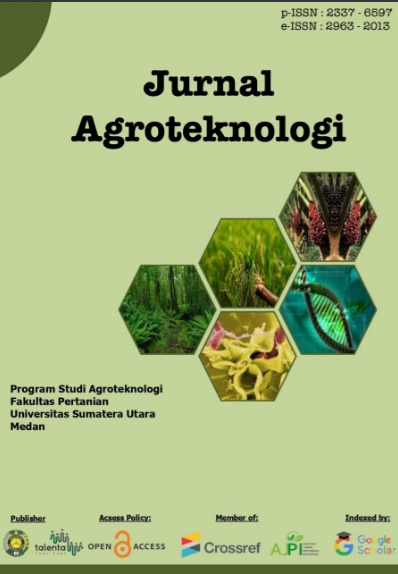The Relationship of Climate Elements to the Productivity of Tea Plants (Camellia sinensis L) in Bah Butong Plantation PTPN IV Tahun 1995-1999
DOI:
https://doi.org/10.32734/ja.v12i1.20575Keywords:
Climate, tea productivity, teaAbstract
Tea productivity is influenced by several factors, one of which is climate. This research aims to determine the influence of climate elements on the productivity of tea at Bah-butong of PT. Nusantara IV, North Sumatra 1995-1999. The hypothesis in this research is that there is a real influence of rainfall, rainy days, sunlight, temperature and humidity, simultaneously and in correlation on tea productivity. This research was carried out from September to December 2023 at an altitude of 910 meters above sea level, with data collection methods through field surveys with secondary data collection at related agencies. The data taken includes data on rainfall, rainy days, sunlight, temperature, humidity and tea production from 1995-1999. The analysis method used is multiple linear regression analysis and correlation analysis using the SPSS.v.22 for Windows statistical tool. The results of the regression analysis show that rainfall, rainy days, amount of sunlight, and temperature have a insignificant effect on increasing tea production. Meanwhile, humidity has a significant individually on increasing tea production. The results of the regression analysis show that climate elements have a significant simultaneous effect on increasing tea production. The correlation of rainfall, rainy days, sunlight, and temperature on tea has a weak influence. Humidity has quite an influence on increasing tea productivity.
Downloads
Downloads
Published
Issue
Section
License
Copyright (c) 2024 JURNAL AGROTEKNOLOGI

This work is licensed under a Creative Commons Attribution-ShareAlike 4.0 International License.
The Authors submitting a manuscript do so on the understanding that if accepted for publication, copyright of the article shall be assigned to Jurnal Online Agroekoteknologi as well as TALENTA Publisher Universitas Sumatera Utara as the publisher of the journal.
Copyright encompasses exclusive rights to reproduce and deliver the article in all forms and media. The reproduction of any part of this journal, its storage in databases and its transmission by any form or media, will be allowed only with written permission from Jurnal Online Agroekoteknologi.
The Copyright Transfer Form can be downloaded here.
The copyright form should be signed originally and sent to the Editorial Office in the form of original mail or scanned document.











